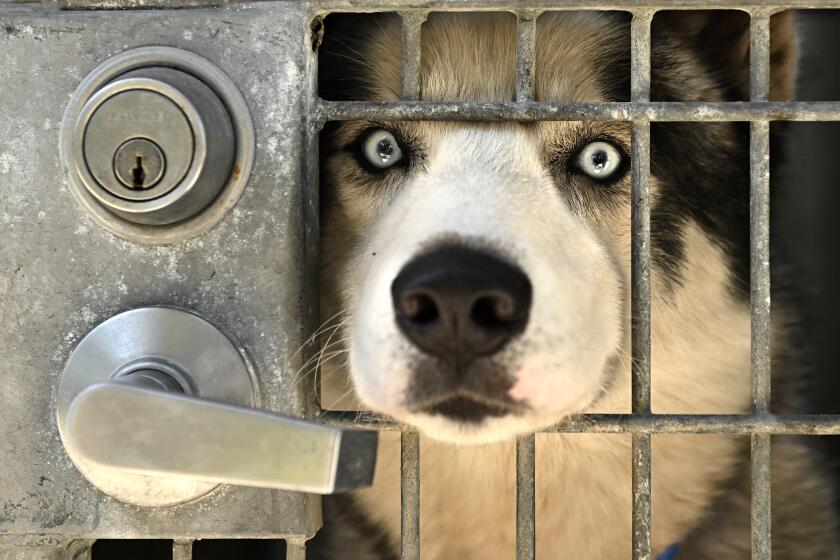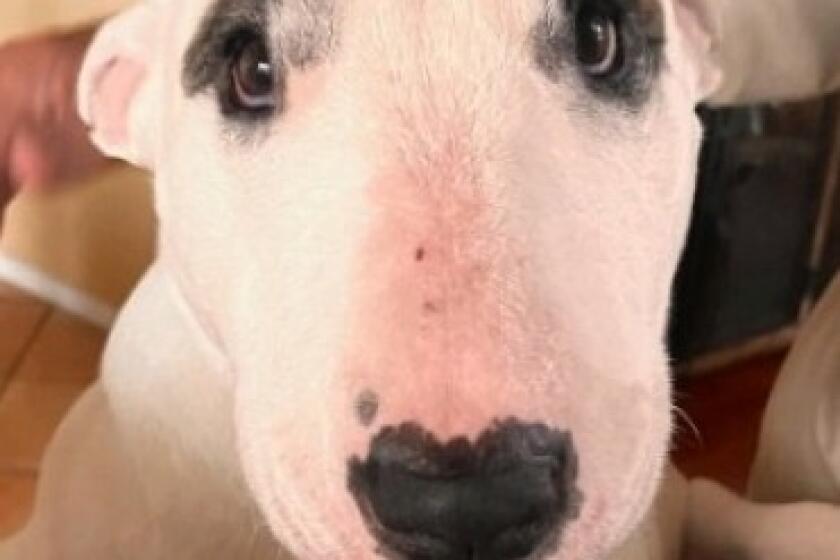What the typical animal rescue narratives leave out

- Share via
In the typical animal rescue story, “before” images might show a sweet pup with matted fur and haunted eyes abandoned in a bleak part of town; the “after” has it joyfully romping in a sleek suburban home, given a new life by a righteous savior. This almost religious parable of redemption has been the standard since the early days of the no-kill/rescue movement. Humane organizations love its emotional appeal, which prompts involvement and brings in donations. So do ordinary citizens because it suggests bad humans are to blame for the awful fact that millions of pets sit trapped in America’s shelters while offering a ready fix (Adopt Don’t Shop!) And it gives us, potential adopters, the chance to play the hero.
But what if that story’s flawed? While researching and writing my book, “Rethinking Rescue,” I spent a lot of time with Lori Weise, the founder of L.A.’s Downtown Dog Rescue who has helped the pets and people of this city’s struggling, underserved communities since the 1990s. And I learned what the typical narrative leaves out.
My wife and I once fostered a corgi to help its troubled owner, who became a friend. But what we thought was a happy ending was only a reprieve.
Some people truly are terrible to animals. They surrender them to shelters when they become inconvenient; they neglect, exploit and brutalize them. But many, even most, of the dogs and cats that roam the streets or languish behind shelter bars were not, as one well-known ASPCA ad suggests, beaten or “locked in a cage alone and left to die.” They weren’t victims of cruelty. Like our society’s other throwaways — foster kids, the incarcerated — these animals were far more likely to have begun their lives in poverty.
Shortages of homes and apartments across the country have driven more dogs and cats into shelters — and spurred a movement for pet-inclusive rental policies.
Around 20 million American pets live in poverty with their owners, and millions more at poverty’s edges. Their people’s class affects these animals’ fates. When people can’t afford spay or neuter surgery, their pets disproportionately produce unwanted (and later surrendered) litters. If a pet gets loose and is taken by animal control to a shelter, its owner is not allowed to take it home without paying a “redemption fee.” Some people who love their pets can’t afford the cost of veterinary care, which has climbed more than 60% in the last 10 years; if a pet becomes sick or injured, they surrender it to the shelter, sometimes in the mistaken belief that an on-site veterinarian will treat it. Many pet owners can’t find pet-friendly rentals or afford extra (often nonrefundable) deposits or “pet rent” — charges that disproportionately affect those with low-income and communities of color.
And these people’s relationships with their pets affect what happens to them. Renters get evicted when landlords suddenly institute or enforce “no pets” rules. Some pet owners who are unhoused stay on the street if the alternative is a refuge that won’t allow a dog or cat. Children are traumatized when their parents’ economic struggles separate them from a beloved pet.
We felt like our adopted dog was a gun with no safety and worried she’d hurt someone.
The animals that fill shelters are less likely to have belonged to humans who abused or didn’t love them than to those who lacked education, information and, most of all, money.
The conventional rescue narrative, repeated by activists who are largely middle-class or affluent, renders these humans invisible — way stations on a pet’s road to a “better” home. Or it lumps them with the true bad guys, whose animals are better off elsewhere. It feeds the contempt that too many Americans already feel for the less fortunate. It’s easy to say something like “I’d sleep on the street before I gave up my dog” when you don’t face that choice.
And practically, this conventional narrative doesn’t solve the problem that America has too many pets in too many shelters.
It’s clear that human poverty is a major driver of pet loss and surrender. During the 2008 recession, shelters across the nation reported being overrun with “a tide of displaced dogs and cats.” Similarly, in 2022, as COVID-19-era child tax credits and some eviction protections expired while inflation grew, surrender numbers exploded. Even in good times, relinquishment rates are consistently higher in disadvantaged neighborhoods. Adoption alone cannot address this.
Fostering puppies helps bring the ‘no kill’ philosophy of animal rescue closer to reality. Besides, is there anything sweeter than being loved by a puppy?
Weise and Downtown Dog Rescue radically flipped the equation. At a time when no one else did it, they helped the unhoused treat, feed, sterilize and keep their pets. Downtown Dog Rescue offered an array of services to low-income pet owners, such as community clinics that provided flea treatments, microchips and vaccinations. They handed out collars and leashes; they paid to redeem and license impounded animals; they provided access to spay and neuter surgery and vital veterinary care, including humane euthanasia. Those senior and terminally ill pets “dumped” at shelters often belong to a family that didn’t know of or couldn’t afford a better way to end the suffering.
A counselor Downtown Dog Rescue stationed at a high-intake shelter asked families considering surrender, “What can I do to help you keep your pet?” — and then did it. Through compassion, understanding and tangible assistance, tens of thousands of at-risk animals stayed out of crowded shelters and with the people that loved them.
The kind of programs Weise pioneered are more mainstream these days, but the old narrative has never lost its hold. It’s time to let it go. Powerful human-animal bonds exist across neighborhoods, races, ages, genders and classes. We can condemn abusers while understanding that those whose only “crime” is being poor deserve help, not blame. The endless flow into shelters, Weise said almost a decade ago, “isn’t a pet problem or a people problem, it’s a poverty problem.”
Carol Mithers lives in L.A. and serves an aging and very demanding rescue dog. Her newest book is “Rethinking Rescue: Dog Lady and the Story of America’s Forgotten People and Pets.”
More to Read
A cure for the common opinion
Get thought-provoking perspectives with our weekly newsletter.
You may occasionally receive promotional content from the Los Angeles Times.













